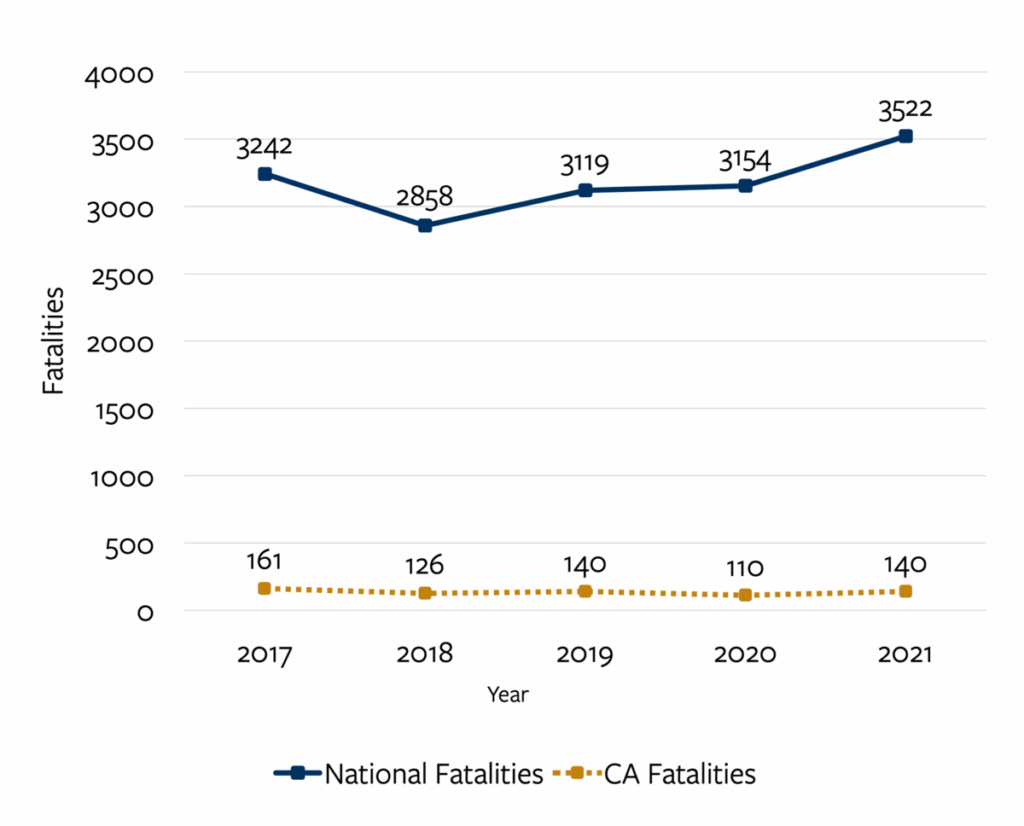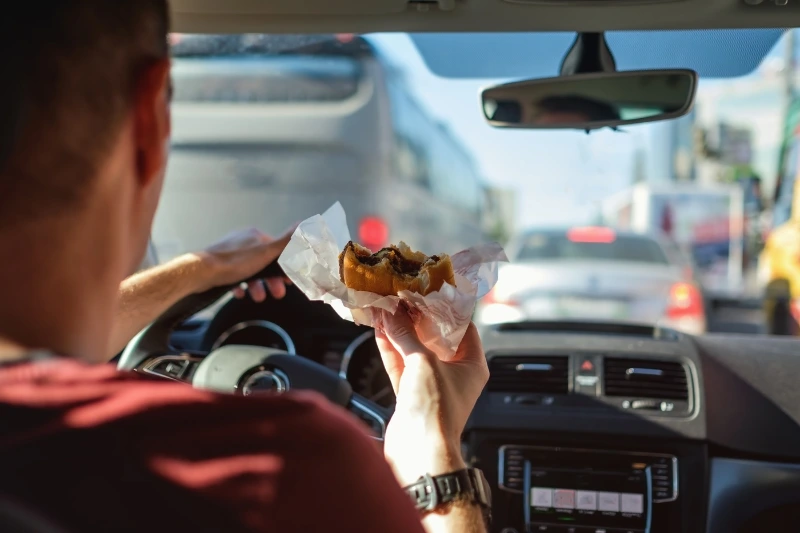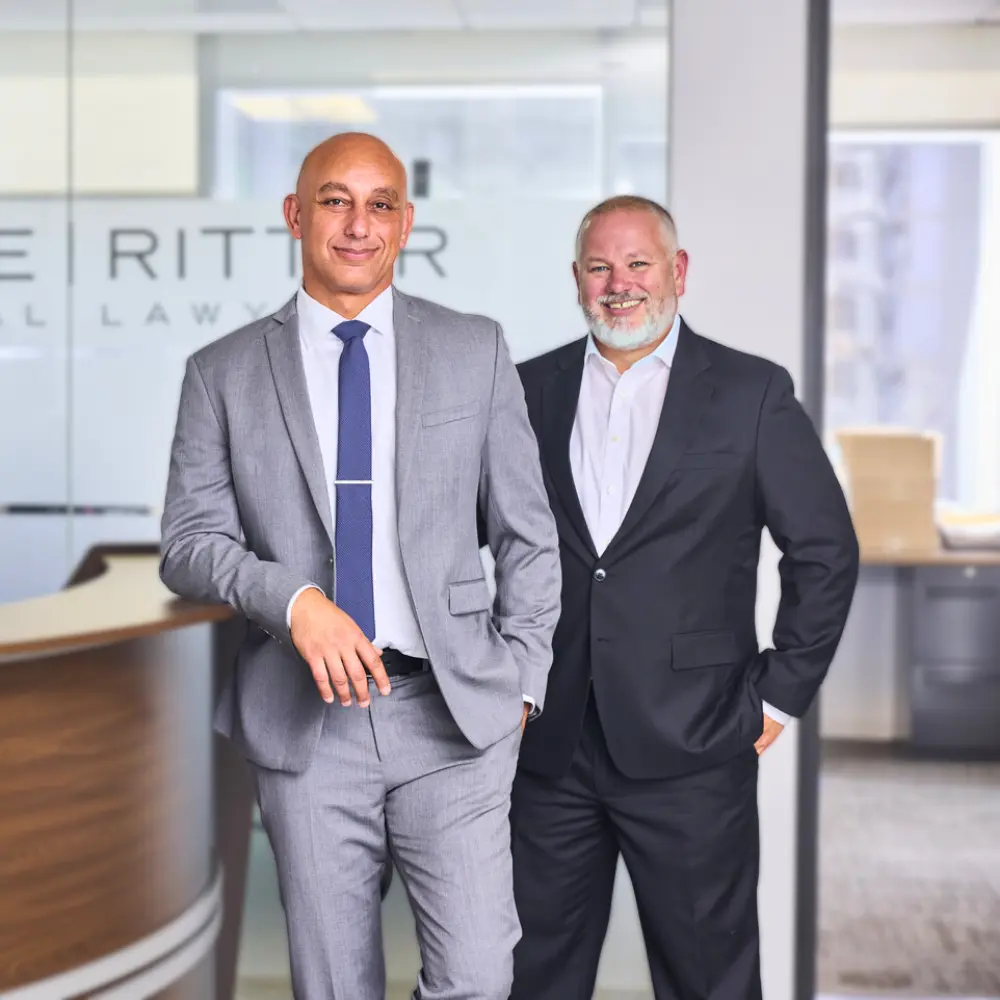A distracted driver isn’t always the person scrolling through their phone. It could just as easily be someone unwrapping a burger, sipping a soda, or trying to balance a hot cup of coffee while steering. Eating in the car may feel harmless or even routine, but the truth is it can be just as risky and sometimes just as deadly as texting behind the wheel.
Distracted Driving in California: It’s Not Just About Phones
When people ask, “Is it illegal to eat while driving in California?” the real issue often comes down to distracted driving.
California law is clear: distracted driving is one of the biggest threats to safety on the road. While most people think about distracted driving as texting or scrolling on a phone, distractions come in many forms, and eating is one of them.
There are three main types of distractions every driver should know:
- Visual – taking your eyes off the road.
- Manual – taking your hands off the wheel.
- Cognitive – shifting your focus away from the road.
Eating behind the wheel can involve all three at once. Looking down to open a wrapper, holding a sandwich instead of the wheel, or focusing on your food instead of surrounding traffic all create dangerous moments. Even a quick bite can set the stage for a serious crash.
| Distraction Type | Texting | Eating |
|---|---|---|
| Visual | Looking at phone | Looking at food |
| Manual | Typing with hands | Holding food/drink |
| Cognitive | Thinking about messages | Thinking about eating |
Distracted Driving Fatality Trends Nationwide and in California
Distracted driving is more than a bad habit; it’s a deadly problem on our roads. According to UC Berkeley’s SafeTREC Traffic Safety Facts: Distracted Driving, 140 people were killed in distracted driving traffic crashes in California in 2021.
Nationwide, thousands more lives are lost every year because drivers take their eyes, hands, or attention away from the road.
These numbers prove that distraction, whether from texting, eating, or even adjusting the radio, can have life-changing consequences.
When you think about how common it is for drivers to grab a quick snack or drink behind the wheel, it’s clear that eating while driving adds to the same dangers that already take far too many lives in California each year.
The chart below shows distracted driving fatalities nationwide and in California from 2017 to 2021, highlighting just how serious the problem is.

Data source: Fatality Analysis Reporting System (FARS) 2017 – 2020 Final File & 2021 ARF
These deadly numbers make it clear why eating behind the wheel, though common, is viewed as a serious distraction.
How California Law Treats Eating Behind the Wheel

While eating behind the wheel isn’t directly outlawed, it can still fall under California’s reckless driving statute. California Vehicle Code §23103 makes it illegal to drive “in willful or wanton disregard for the safety of persons or property.”
In simple terms, this means that if your actions show a careless disregard for safety, you can be charged with reckless driving.
Eating while driving may seem minor, but it can create the kind of dangerous situations that fit this definition. For example, a driver who spills food, swerves across lanes, or speeds through an intersection while distracted could face a reckless driving charge.
Penalties for reckless driving may include:
- Jail time in severe cases
- Fines
- Points on your license
- Higher insurance rates
On top of criminal consequences, reckless driving caused by eating can also make you liable in a civil lawsuit. Courts in California have ruled that distractions, such as eating, can be a “substantial factor” in causing a crash.
That means you could be held responsible for medical bills, lost wages, and pain and suffering if your distraction causes harm to someone else.
Why Eating While Driving Is More Dangerous Than You Think
There may not be a specific law that bans eating while driving, but that doesn’t make it safe. So, is it illegal to eat while driving in California? Not exactly, but if food or drinks take your hands, eyes, or focus off the road, it can still be considered distracted driving.
Here are some real-world examples:
- A driver spills hot coffee in their lap and slams into the car ahead.
- Someone unwraps a burger and drifts into another lane.
- A driver reaches for food and misses a red light.
“Distracting behaviors such as eating and texting while driving appear to negatively impact driving measures of lane position control and reaction time.” – Journal of Safety Research, 2014
Research backs up how dangerous this can be. According to a 2014 study published in the Journal of Safety Research, eating or drinking while driving is strongly linked to a higher crash risk, much like other common distractions. Even simple actions like sipping a drink can slow reaction times and pull attention away from the road.
These actions aren’t just inconvenient; they’re risky. Eating reduces reaction times, creates messy spills, and leaves only one hand on the wheel. Even a split-second delay can cause a serious accident.
How Eating While Driving Can Affect Your Insurance Claim
If you were injured by a distracted driver, their insurance company may try to downplay your injuries or argue you share some of the blame. Eating behind the wheel isn’t directly illegal, but insurers often use it as proof of distraction to reduce what they pay out.
However, even if you were eating or drinking when the crash happened, you may still be able to recover compensation.
California follows comparative negligence laws, which means you can pursue damages even if you were partially at fault. What matters most is proving the other driver’s negligence caused the accident.
Our skilled car accident lawyer can gather the evidence, challenge the insurance company’s arguments, and fight to protect the full value of your claim.
Frequently Asked Questions About Eating While Driving in California
Can you really get a ticket for eating while driving in California?
Yes. Eating isn’t directly banned, but police can cite you if it distracts you or causes unsafe driving. Under California Vehicle Code §23103, even spilling coffee or swerving while eating can count as reckless driving.
Does eating while driving affect my insurance claim?
It can. Insurance companies may argue you were distracted and try to reduce or deny your claim if eating contributed to the crash.
What if I was eating and got hit by another driver?
You may still recover compensation. California’s comparative negligence law allows claims even if you were partially distracted. A personal injury lawyer can prove the other driver’s fault and protect your case.
Let Us Protect Your Rights After a Car Accident
After a crash, it’s normal to feel overwhelmed, especially if the other driver was distracted by something like eating behind the wheel. Medical bills, car repairs, and insurance calls can pile up fast. That’s where our attorneys step in.
Here’s how we can help:
- Investigate the accident – We gather police reports, witness statements, and any proof that the other driver was distracted.
- Prove negligence – If eating or another distraction caused the crash, we show how it contributed to your injuries.
- Handle the insurance company – We push back against lowball offers and fight for the full compensation you deserve.
- Recover damages – From medical bills and lost wages to pain and suffering, we work to secure a fair settlement or verdict.
With decades of experience, our team knows the tactics insurers use and how to challenge them. We offer free consultations, and you pay nothing unless we win your case.
Support, Guidance, and Results. Call Today!

Your recovery matters, and every day counts. Don’t let a distracted driver’s mistake define your future. Whether the other driver was eating, texting, or simply not paying attention, we’re here to fight for you.
With over 60 years of combined experience representing California accident victims, our car accident attorneys know how to secure the compensation you need to rebuild and move forward.
Reach out today for a free consultation—we’ll stand by you every step of the way!
Disclaimer: The information provided in this blog post is not intended as legal advice and should not be relied upon as such. You should consult with an experienced attorney for advice on your specific situation.
